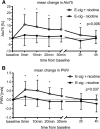Acute Effects of Electronic Cigarette Inhalation on the Vasculature and the Conducting Airways
- PMID: 30963443
- PMCID: PMC6746878
- DOI: 10.1007/s12012-019-09516-x
Acute Effects of Electronic Cigarette Inhalation on the Vasculature and the Conducting Airways
Abstract
The use of electronic cigarettes has increased exponentially since its introduction onto the global market in 2006. However, short- and long-term health effects remain largely unknown due to the novelty of this product. The present study examines the acute effects of e-cigarette aerosol inhalation, with and without nicotine, on vascular and pulmonary function in healthy volunteers. Seventeen healthy subjects inhaled electronic cigarette aerosol with and without nicotine on two separate occasions in a double-blinded crossover fashion. Blood pressure, heart rate, and arterial stiffness measured by pulse wave velocity and pulse wave analysis were assessed at baseline, and then at 0 h, 2 h, and 4 h following exposure. Dynamic spirometry and impulse oscillometry were measured following vascular assessments at these time points, as well as at 6 h following exposure. e-Cigarette aerosol with nicotine caused a significant increase in heart rate and arterial stiffness. Furthermore, e-cigarette aerosol-containing nicotine caused a sudden increase in flow resistance as measured by impulse oscillometry, indicating obstruction of the conducting airways. Both aerosols caused an increase in blood pressure. The present study indicates that inhaled e-cigarette aerosol with nicotine has an acute impact on vascular and pulmonary function. Thus, chronic usage may lead to long-term adverse health effects. Further investigation is warranted.
Keywords: Arterial stiffness; Augmentation index; ENDS; Electronic cigarettes; IOS; Pulse wave velocity; e-Cig.
Conflict of interest statement
The authors declare that they have no competing interests.
Figures




Similar articles
-
E-cigarettes and cigarettes worsen peripheral and central hemodynamics as well as arterial stiffness: A randomized, double-blinded pilot study.Vasc Med. 2018 Oct;23(5):419-425. doi: 10.1177/1358863X18779694. Epub 2018 Jul 9. Vasc Med. 2018. PMID: 29985113 Clinical Trial.
-
Acute and chronic sympathomimetic effects of e-cigarette and tobacco cigarette smoking: role of nicotine and non-nicotine constituents.Am J Physiol Heart Circ Physiol. 2020 Aug 1;319(2):H262-H270. doi: 10.1152/ajpheart.00192.2020. Epub 2020 Jun 19. Am J Physiol Heart Circ Physiol. 2020. PMID: 32559135 Free PMC article.
-
Acute effects of electronic cigarettes on arterial pressure and peripheral sympathetic activity in young nonsmokers.Am J Physiol Heart Circ Physiol. 2021 Jan 1;320(1):H248-H255. doi: 10.1152/ajpheart.00448.2020. Epub 2020 Nov 8. Am J Physiol Heart Circ Physiol. 2021. PMID: 33164580 Clinical Trial.
-
Cardiovascular toxicity of nicotine: Implications for electronic cigarette use.Trends Cardiovasc Med. 2016 Aug;26(6):515-23. doi: 10.1016/j.tcm.2016.03.001. Epub 2016 Mar 10. Trends Cardiovasc Med. 2016. PMID: 27079891 Free PMC article. Review.
-
Immunological and toxicological risk assessment of e-cigarettes.Eur Respir Rev. 2018 Feb 28;27(147):170119. doi: 10.1183/16000617.0119-2017. Print 2018 Mar 31. Eur Respir Rev. 2018. PMID: 29491036 Free PMC article. Review.
Cited by
-
Recent findings in the pharmacology of inhaled nicotine: Preclinical and clinical in vivo studies.Neuropharmacology. 2020 Oct 1;176:108218. doi: 10.1016/j.neuropharm.2020.108218. Epub 2020 Jun 24. Neuropharmacology. 2020. PMID: 32592708 Free PMC article. Review.
-
In Vitro Biological Effects of E-Cigarette on the Cardiovascular System-Pro-Inflammatory Response Enhanced by the Presence of the Cinnamon Flavor.Toxics. 2022 Dec 14;10(12):784. doi: 10.3390/toxics10120784. Toxics. 2022. PMID: 36548617 Free PMC article.
-
Influence of Nicotine from Diverse Delivery Tools on the Autonomic Nervous and Hormonal Systems.Biomedicines. 2022 Jan 6;10(1):121. doi: 10.3390/biomedicines10010121. Biomedicines. 2022. PMID: 35052800 Free PMC article.
-
E-Cigarettes and Cardiopulmonary Health: Review for Clinicians.Circulation. 2022 Jan 18;145(3):219-232. doi: 10.1161/CIRCULATIONAHA.121.056777. Epub 2022 Jan 18. Circulation. 2022. PMID: 35041473 Free PMC article. Review.
-
Cardiovascular and Pulmonary Responses to Acute Use of Electronic Nicotine Delivery Systems and Combustible Cigarettes in Long-Term Users.Chest. 2023 Sep;164(3):757-769. doi: 10.1016/j.chest.2023.03.047. Epub 2023 Apr 10. Chest. 2023. PMID: 37044158 Free PMC article.
References
-
- Lim SS, Vos T, Flaxman AD, Danaei G, Shibuya K, Adair-Rohani H, et al. A comparative risk assessment of burden of disease and injury attributable to 67 risk factors and risk factor clusters in 21 regions, 1990–2010: A systematic analysis for the Global Burden of Disease Study 2010. Lancet. 2012;380(9859):2224–2260. doi: 10.1016/S0140-6736(12)61766-8. - DOI - PMC - PubMed
-
- WHO. (2015). WHO global report on trends in prevalence of tobacco smoking. Retrieved December 5, 2017, from http://www.who.int/tobacco/publications/surveillance/reportontrendstobac....
Publication types
MeSH terms
Substances
LinkOut - more resources
Full Text Sources
Medical
Molecular Biology Databases

